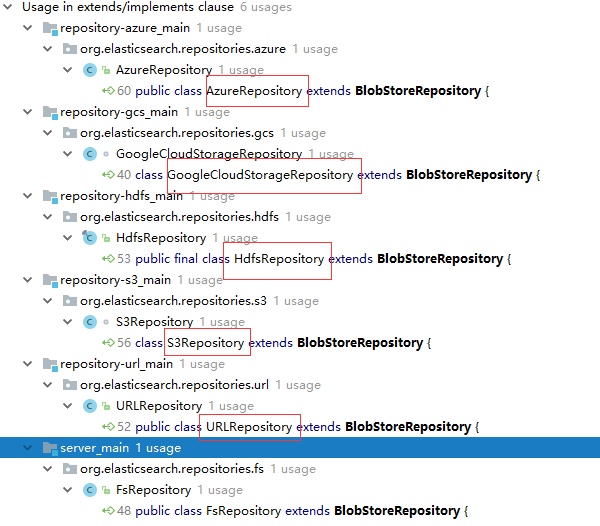1.RepositoriesModule概述
Sets up classes for Snapshot/Restore
1.1 snapshot概述
A snapshot is a backup taken from a running Elasticsearch cluster. You can take a snapshot of individual indices or of the entire cluster and store it in a repository on a shared filesystem, and there are plugins that support remote repositories on S3, HDFS, Azure, Google Cloud Storage and more. Snapshots are taken incrementally. This means that when creating a snapshot of an index Elasticsearch will avoid copying any data that is already stored in the repository as part of an earlier snapshot of the same index. Therefore it can be efficient to take snapshots of your cluster quite frequently. Snapshots can be restored into a running cluster via the restore API. When restoring an index it is possible to alter the name of the restored index as well as some of its settings, allowing a great deal of flexibility in how the snapshot and restore functionality can be used.
1.2 repository
You must register a snapshot repository before you can perform snapshot and restore operations. We recommend creating a new snapshot repository for each major version. The valid repository settings depend on the repository type.
If you register same snapshot repository with multiple clusters, only one cluster should have write access to the repository. All other clusters connected to that repository should set the repository to readonly mode.
实例:备份
PUT /_snapshot/my_backup { "type": "fs", "settings": { "location": "my_backup_location" } }
恢复
POST /_snapshot/my_backup/snapshot_1/_restore
删除
DELETE /_snapshot/my_backup/snapshot_1
监控
GET /_snapshot/my_backup/snapshot_1/_status
2.配置类BlobStoreRepository
protected BlobStoreRepository(RepositoryMetaData metadata, Settings globalSettings, NamedXContentRegistry namedXContentRegistry) { super(globalSettings); this.metadata = metadata; this.namedXContentRegistry = namedXContentRegistry; snapshotRateLimiter = getRateLimiter(metadata.settings(), "max_snapshot_bytes_per_sec", new ByteSizeValue(40, ByteSizeUnit.MB)); restoreRateLimiter = getRateLimiter(metadata.settings(), "max_restore_bytes_per_sec", new ByteSizeValue(40, ByteSizeUnit.MB)); readOnly = metadata.settings().getAsBoolean("readonly", false); indexShardSnapshotFormat = new ChecksumBlobStoreFormat<>(SNAPSHOT_CODEC, SNAPSHOT_NAME_FORMAT, BlobStoreIndexShardSnapshot::fromXContent, namedXContentRegistry, isCompress()); indexShardSnapshotsFormat = new ChecksumBlobStoreFormat<>(SNAPSHOT_INDEX_CODEC, SNAPSHOT_INDEX_NAME_FORMAT, BlobStoreIndexShardSnapshots::fromXContent, namedXContentRegistry, isCompress()); ByteSizeValue chunkSize = chunkSize(); if (chunkSize != null && chunkSize.getBytes() <= 0) { throw new IllegalArgumentException("the chunk size cannot be negative: [" + chunkSize + "]"); } }
配置类的实现

3.重点类
3.1 SnapshotsService
创建snapshot
/** * Service responsible for creating snapshots * <p> * A typical snapshot creating process looks like this: * <ul> * <li>On the master node the {@link #createSnapshot(SnapshotRequest, CreateSnapshotListener)} is called and makes sure that no snapshots is currently running * and registers the new snapshot in cluster state</li> * <li>When cluster state is updated the {@link #beginSnapshot(ClusterState, SnapshotsInProgress.Entry, boolean, CreateSnapshotListener)} method * kicks in and initializes the snapshot in the repository and then populates list of shards that needs to be snapshotted in cluster state</li> * <li>Each data node is watching for these shards and when new shards scheduled for snapshotting appear in the cluster state, data nodes * start processing them through {@link SnapshotShardsService#processIndexShardSnapshots(ClusterChangedEvent)} method</li> * <li>Once shard snapshot is created data node updates state of the shard in the cluster state using the {@link SnapshotShardsService#sendSnapshotShardUpdate(Snapshot, ShardId, ShardSnapshotStatus)} method</li> * <li>When last shard is completed master node in {@link SnapshotShardsService#innerUpdateSnapshotState} method marks the snapshot as completed</li> * <li>After cluster state is updated, the {@link #endSnapshot(SnapshotsInProgress.Entry)} finalizes snapshot in the repository, * notifies all {@link #snapshotCompletionListeners} that snapshot is completed, and finally calls {@link #removeSnapshotFromClusterState(Snapshot, SnapshotInfo, Exception)} to remove snapshot from cluster state</li> * </ul> */
3.2 RestoreService
/** * Service responsible for restoring snapshots * <p> * Restore operation is performed in several stages. * <p> * First {@link #restoreSnapshot(RestoreRequest, org.elasticsearch.action.ActionListener)} * method reads information about snapshot and metadata from repository. In update cluster state task it checks restore * preconditions, restores global state if needed, creates {@link RestoreInProgress} record with list of shards that needs * to be restored and adds this shard to the routing table using {@link RoutingTable.Builder#addAsRestore(IndexMetaData, SnapshotRecoverySource)} * method. * <p> * Individual shards are getting restored as part of normal recovery process in * {@link IndexShard#restoreFromRepository(Repository)} )} * method, which detects that shard should be restored from snapshot rather than recovered from gateway by looking * at the {@link ShardRouting#recoverySource()} property. * <p> * At the end of the successful restore process {@code RestoreService} calls {@link #cleanupRestoreState(ClusterChangedEvent)}, * which removes {@link RestoreInProgress} when all shards are completed. In case of * restore failure a normal recovery fail-over process kicks in. */

微信公众号: 架构师日常笔记 欢迎关注!



 浙公网安备 33010602011771号
浙公网安备 33010602011771号